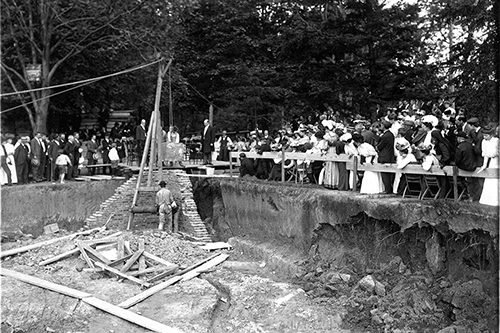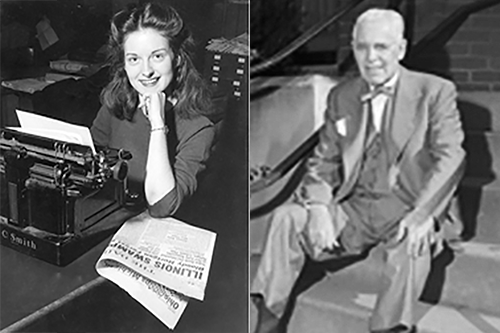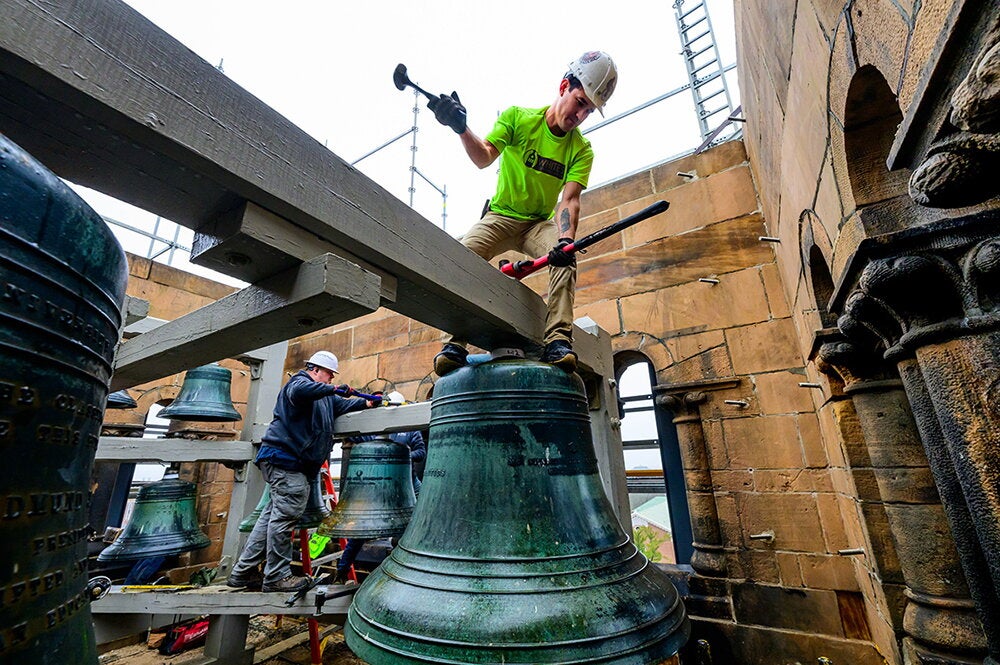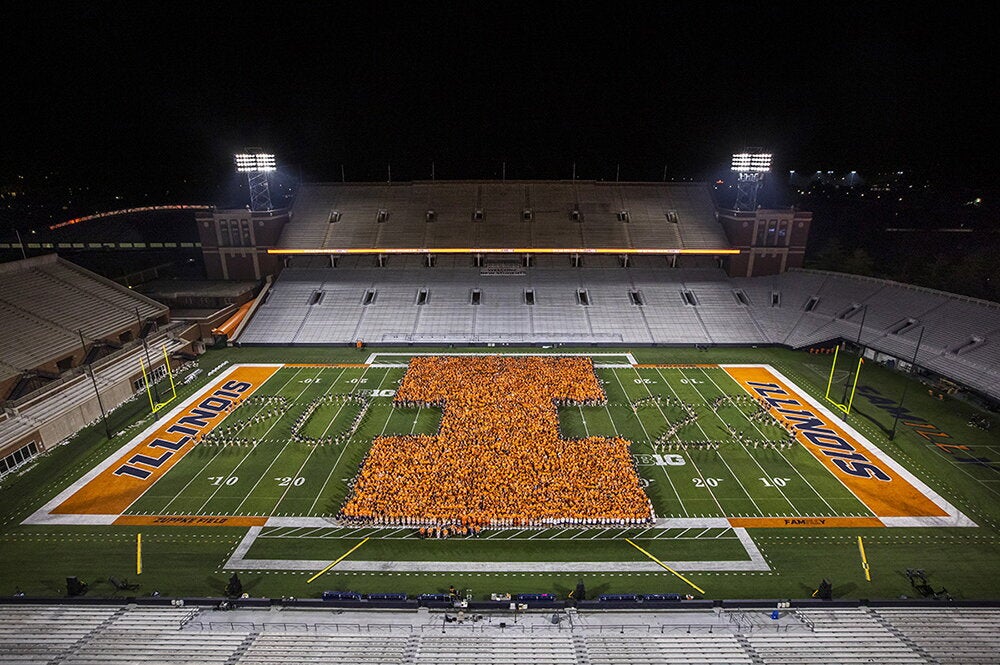

Some buildings get all the glory. At U of I, Lincoln Hall has its presidential connection, Altgeld Hall has its chimes, English Building has its ghost. But what about the workhorses—the gritty brick behemoths whose claim to fame isn’t their name or design, but their practicality, and the fact that over the years they’ve served as everything from faculty offices to bowling alleys and war barracks? What about Illini Hall?
Not a lot has been written about Illini Hall. Situated at the corner of Wright and John streets, the 160-foot-long, three-story act of Elizabethan revival architecture may be the most overlooked 40,000-square-foot building on campus. Maybe that’s because it’s overshadowed by some of the most picturesque and exciting places at U of I: Altgeld Hall, the Main Quad, Illini Union, Green Street, and other landmarks are all within shouting distance of Illini Hall. Nobody ever says, “Looking for the Alma Mater? It’s just east of Illini Hall.”
Illini Hall’s relative obscurity really isn’t fair. Not only is it one of the older buildings on campus—built in 1907, it’s older than Lincoln Hall, the Armory, and University Library, to name a few—but it’s also served a variety of important purposes.
Today it houses faculty offices for the departments of Mathematics and Statistics, computer labs for campus’ Technology Services, and three classrooms. To make space for a new data science center, however, as part of the Altgeld and Illini Hall Project, the 112-year-old building is scheduled to be torn down and replaced by 2023.
The decision to replace Illini Hall was made carefully. Project planners evaluated the building closely, but they determined that it would be too expensive to renovate Illini Hall in a way that enables the necessary expansion of educational and research capacity in mathematical and data sciences. Current plans call for a six-story building to be built on the site of Illini Hall.
Planners have been in contact with the Illinois State Historic Preservation Office, however, to ensure that the removal of Illini Hall is done in a manner that respects and documents the historical significance of the building. It’s already been determined that Illini Hall has been the site of some remarkable and enduring changes at Illinois.
According to Dennis Craig, the campus historic preservation officer at U of I’s Facilities and Services, Illini Hall was built originally to house the U of I’s YMCA, which was the first YMCA at an educational institution in the state. The popular organization had outgrown space in other buildings, including Altgeld Hall, and in 1905 it purchased the land where Illini Hall sits today.

Congressman W.B. McKinley (namesake for the McKinley Health Center) served on the building committee, and during the 1905 commencement ceremony he announced a gift of $15,000 (and later made another gift of $20,000) toward the $100,000 required to construct the new building. The cornerstone for Illini Hall—back then it was known as the YMCA building—was laid on June 11, 1907, in a ceremony attended by W.L. Abbott, president of the University Board of Trustees.
“Designed by the Philadelphia architectural firm of Temple, Burrows and McLane, (the building) was described as ‘imposing,’ being 160 feet long and covering only half of the lot area, so that it could be doubled in size in the future,” Craig said. “The building has three stories with a basement. The first floor included parlors with fireplaces. The basement had a large café and lunchroom, along with a barber shop, club rooms, and four bowling alleys. The second and third floors had meeting rooms and dormitory rooms.”
The YMCA used the building extensively. The building housed almost 90 male students, making it, in effect, the university’s first dormitory, according to the YMCA. In 1918, the YMCA began providing organized service to international students, which was a new concept, as there were only about 200 international students at U of I at that time.
During World War I, however, the university, in conjunction with the School of Military Aeronautics, converted the YMCA building into a war barracks. The building underwent numerous modifications for this role, and the YMCA moved out. After the war, the Board of Trustees leased the first floor of the YMCA building to the Illini Union Association, which turned the space into the first student union at Illinois.
The Illinois Union Association thrived for the next couple of decades in its new location—which switched its name from the YMCA building to the Illinois Union Building—and was joined in the space by the University of Illinois Alumni Association and other student organizations until the present Illini Union was constructed in 1941.
Thus ended Illini Hall’s stint as the first student union at the U of I, but the university subsequently bestowed the current name upon the building and used it to house a variety of organizations, including the Police Training Institute, a speech research program, and The Daily Illini until the newspaper relocated in 1988.
As the storyline on Illini Hall comes to an end, it’s appropriate to reflect upon one more enduring tradition. While Illinois can’t claim to be the first university to celebrate homecoming, historians agree that it’s among the top five schools to begin what’s become a universal annual college tradition. Like many good ideas, the idea came together quickly, during an informal meeting in 1909 between students C.F. Williams, a member of the Phi Kappa Psi fraternity, and W. Elmer Ekblaw, editor of the Daily Illini.
Where did this brilliant fit of brainstorming take place? Hint: It’s just west of the Alma Mater.
Update on the Altgeld and Illini Hall Project
Campus officials plan to soon present schematic plans to the Board of Trustees for the renovation of Altgeld Hall and the construction of a new building on the site of Illini Hall. The new building is slated for completion by 2023, and Altgeld Hall is to be renovated by 2025. Visit the project website for more details.
Editor's note: This story originally appeared in the Spring 2020 issue of LAS News magazine.


